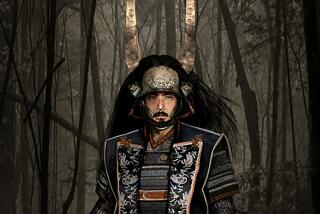MOVIE REVIEW : ‘Silk Road’: Epic and Intimate
- Share via
At the turn of the century, a wandering Taoist monk discovered in one of the ancient excavated caves near Dun Huang, a military outpost on the northwestern frontier of China, 40,000 manuscripts that had been hidden behind a brick wall nine centuries earlier. No one has solved the mystery of why these documents, an archeological treasure trove without parallel, were secreted, but in 1959 prize-winning Japanese novelist Yasushi Inoue wrote a novel proposing a solution.
This novel has now been adapted to the screen as “The Silk Road” (at the Hillcrest Cinemas), the most ambitious Sino-Japanese co-production ever, a sweeping romantic historical epic with a cast of thousands, awesome battle scenes, glorious sets and costumes, a robust yet poignant score by the masterly Masaru Sato and, at its heart, a stirring saga of love and revenge. Although filmed in authentic locales in China, it is in the now nearly extinct tradition of the splendiferous Japanese period spectacle.
It brings to mind the wonderfully entertaining films of the late Hiroshi Inagaki--his “Chushingura” became a long-running cult film in America--who, like Cecil B. DeMille, loved to tell a great story for its own sake and with a grand flourish.
The year is 1026, and, at that time, Dun Huang was important primarily as a military base along the Silk Road, which connected China with Central Asia and the Western world. At this period of the Sung Dynasty, China was politically and militarily weak, and various ethnic tribes, each with its own outpost in this desert region, were tempted to take advantage of the situation. One of the most aggressive peoples were the Xixians, bent upon overrunning Dun Huang.
“The Silk Road’s” hero, Zhao Xingde (Koichi Sato), is a young scholar of good family who dozes off while waiting for his all-important civil service exams. Missing these exhaustive tests is such a disgrace that he is propelled into an odyssey that will find him becoming a trusted soldier for the gruff, shrewd and fearless Gen. Zhu Wangli (Toshiyuki Nishida), leader of Xixia’s Chinese mercenary troops. These two very different men become fast friends who both fall in love with a beautiful princess (Anna Nakagawa) whose homeland has been conquered by the Xixians.
It is crucial to comprehend this basic plot and background information for all that occurs in the course of the film. Once it is grasped, the film becomes an involving saga in which personal and political destinies become intertwined. The linchpin of the film is the staunch, noble friendship between Zhao and Zhu, who are well-acted by Sato and Nishida, respectively. Adapted to the screen by Tsuyoshi Yoshida and Junya Sato, “The Silk Road” (rated PG-13 for violence) was directed with consistent panache by Junya Sato, co-director of the first Sino-Japanese co-production, the similarly large-scale yet intimate and stirring “The Go Masters” (1982).
‘The Silk Road’
Koichi Sato: Zhao Xingde
Toshiyuki Nishida: Zhu Wangli
Tsunehiko Watase: Li Yuanhao
Daijiro Harada: Weichi Kuang
Takahiro Tamada: Tsao Yanhui
Anna Nakagawa: Tsurpia
Yoshiko Mita: Woman of Xixia
A Trimark Pictures release of a Daiei Co. Ltd., Dentsu Inc. and Marubeni production. Director Junya Sato. Producers Yoshiro Yuki, Masahiro Sato, Mu Wanliang. Executive producers Yasuyoshi Tokuma, Gohei Kogure, Kazuo Haruna. Screenplay by Tsuyoshi Yoshida, Sato. Cinematographer Akira Shizuka. Editor Akira Suzuki. Music Masaru Sato. Art directors Hiroshi Tokuda, Kou Honglie. Sound Ysu Hashimoto. In Japanese, with English subtitles. Running time: 2 hours, 26 minutes.
MPAA-rated PG-13 (for violence).
More to Read
Only good movies
Get the Indie Focus newsletter, Mark Olsen's weekly guide to the world of cinema.
You may occasionally receive promotional content from the Los Angeles Times.










